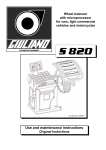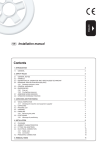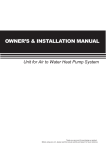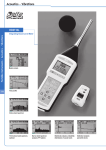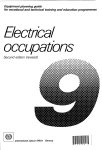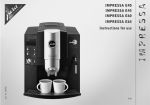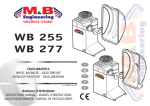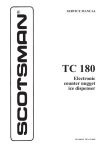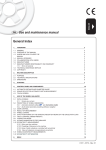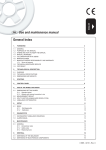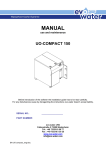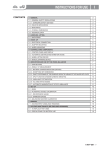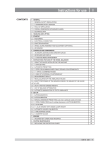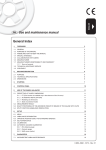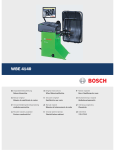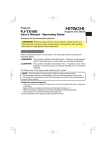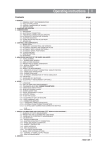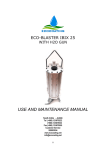Download Use and maintenance instructions - Autec
Transcript
Electronic wheel-balancer with microprocessor and 3-D graphics Touch Screen, for passenger cars, LCVs and motorcycles S 850 Ed. 09/12 Cod. 3036622 Use and maintenance instructions Original Instrictions DECLARATION DE CONFORMITE CE CE DECLARATION OF CONFORMITY DICHIARAZIONE DI CONFORMITA CE CE - ÜBEREINSTIMMUNG DECLARACIÓN CE DE CONFORMIDAD GIULIANO INDUSTRIAL S.p.A. - Via Guerrieri, 6 - 42015 Correggio (RE) ITALY dichiara sotto la propria esclusiva responsabilità che il prodotto: declare on our own responsibility that the product: Déclare sous son propre responsabilité que le produit: erklärt unter ihrer eigenen Verantwortung, daß das Erzeugnis: declara bajo su exclusiva responsabilidad que el producto: Equilibratrice Balancer Equilibreuse S850 Auswuchtmaschine Equilibradora Matricola al quale questa dichiarazione si riferisce E' CONFORME ALLE SEGUENTI DIRETTIVE: to which declaration refers is in conformity with the FOLLOWING DIRECTIVES: au quel cette déclaration se rapporte EST CONFORME AUX DIRECTIVES SUIVANTES: darauf diese Erklärung Bezug nimmt, mit den folgenden Bestimmungen übereinstimmt: 2006/42/CE - 2006/95/CE - 2004/108/CE ed alle Norme: as well as to the following norms: ainsi qu’aux normes suivantes: und folgender Vorschrift gemäß: EN 12100-1:2005 - EN 13850:2007 - EN 61000-6-3:2007 - EN 12100-2:2005 EN 7731:2009 - EN 61000-6-1:2007 - EN 294:1993 - EN 60204-1:2006 EN 61000-6-4:2007 - EN 349:2008 - EN 60439-1:2000 - EN 61000-6-2:2006 Il firmatario della presente dichiarazione è la persona autorizzata a costituire il fascicolo tecnico The signer of this declaration of conformity is the person authorized to provide for the technical file literature Le signataire de cette déclaration de conformité est la personne autorisée à produire le dossier technique Der Unterzeichner dieser CE-Übereinstimmung ist dazu ermächtigt, das technische Aktenbündel vorzulegen El firmante de esta declaración es la persona autorizada para elaborar el expediente técnico Correggio, 10/05/2012 GIULIANO INDUSTRIAL S.p.A Il modello della presente dichiarazione è conforme alla Norma EN ISO/IEC 17050-1 The model of present declaration is in conformity with directive EN ISO/IEC 17050-1 Le modèle de cette déclaration est conforme à la Norme EN ISO/IEC 17050-1 Das Modell dieser Erklärung übereinstimmt mit der Bestimmung EN ISO/IEC 17050-1 El modelo de esta afirmación está en consonancia con la norma EN ISO/IEC 17050-1 Il Presidente CdA Gianluca Maselli DICHIARAZIONE DI CONFORMITA’ RAEE RAEE DECLARATION OF CONFORMITY DECLARATION DE CONFORMITE RAEE RAEE - ÜBEREINSTIMMUNG GIULIANO INDUSTRIAL S.p.A. - Via Guerrieri, 6 - 42015 Correggio (RE) ITALY dichiara sotto la propria esclusiva responsabilità che il prodotto: declare on our own responsibility that the product: Déclare sous son propre responsabilité que le produit: erklärt unter ihrer eigenen Verantwortung, daß das Erzeugnis: Equilibratrice ruote Equilibreuse de roue Wheel-balancer Radauswuchtmaschine al quale questa dichiarazione si riferisce E’ CONFORME ALLA DIRETTIVA: to which declaration refers is in conformity with the FOLLOWING DIRECTIVE: au quel cette déclaration se rapporte EST CONFORME À LA DIRECTIVES SUIVANTES: darauf diese Erklärung Bezug nimmt, mit der folgenden Bestimmungen übereinstimmt: 2002/96/CE e 2003/108/CE (RAEE) Raccolta differenziata Specific garbage collection Collecte sélective getrennte Müllsammlung La presente macchina/apparecchiatura rientra nelle prescrizioni della Direttiva 2002/96/CE e 2003/108/CE (RAEE) e non può essere smaltita come rifiuto urbano generico ma attraverso raccolta separata; Il simbolo del bidone barrato riportato sul prodotto indica questa prescrizione. Lo smaltimento della stessa e dei suoi componenti dovrà avvenire secondo quanto previsto dalle Direttive 2002/96/CE e 2003/108/CE (RAEE) e le disposizioni di Legge del Paese di destinazione della macchina/apparecchiatura; il mancato rispetto della direttiva è sanzionabile secondo le disposizioni di Legge del Paese di dstinazione. L’abbandono o smaltimento non corretto delle macchine/apparecchiature sottoposte alla Direttiva 2002/96/CE può provocare gravi danni all’ambiente ed alle persone. Il costruttore è disponibile, ai sensi della Direttiva, allo smaltimento della macchina/apparecchiatura; per questo servizio contattare il costruttore o i rivenditori autorizzati secondo il Paese di destinazione della macchina/apparecchiatura. This equipment is subject to the regulations foreseen by Directives 2002/96/CE and 2003/108/CE (RAEE) and therefore it cannot be scrapped as a generic scrap material but through specific collection circuits; the symbol with “barred tank” marked on the product refers to this prescription. Scrapping must be made in accordance with Directives 2002/96/CE and 2003/108/CE (RAEE) as well as with the local Regulations in force in the Country of installation, the non-respect of the Directive is subject to sanctions according to the national Laws of the Country of destination. Abandonment or wrong scrapping of the equipment subject to Directive 2002/96/CE can cause serious damage to the environment. The manufacturer is available, according to the Directive, to scrap the equipment; for this service, please contact the manufacturer or your dealer. Ce produit rentre dans les prescriptions des Directives 2002/96/CE et 2003/108/CE (RAEE) et il ne peut donc pas être mis à la ferraille comme du matériel générique mais à travers un circuit de collecte sélective; le symbole du « bidon barré » reproduit sur la machine se réfère à cette prescription. Le traitement de la machine et de ses composants devra se réaliser en conformité aux Directives 2002/96/CE et 2003/108/CE (RAEE) ainsi qu’aux dispositions de Loi en vigueur dans le Pays de destination de la machine, le non-respect de la Directive est passible de sanctions par rapport aux Lois nationales du Pays de destination. L’abandon ou un traitement erroné des produits sujets à la Directive 2002/96/CE peut provoquer de graves dégâts à l’environnement. Le constructeur est disposé, aux termes de la Directive, à s’occuper du traitement de la machine; pour ce service contacter le constructeur ou les revendeurs autorisés. Die vorliegende Maschine/Gerät fällt in den Vorschriften der 2002/96/CE Richtlinie, und kann nicht als allgemeiner Stadtmüll sondern durch getrennte Müllsammlung beseitigt werden; das Symbol mit der durchgestrichenen Mülltonne weist auf diese Vorschrift hin. Die Entsorgung des Gerätes und seiner Bestandteilen muss nach den 2002/96/CE und 2003/108/CE (RAEE) Richtlinien und nach den Vorschriften des Bestimmungslandes der Maschine/Gerätes erfolgen, die Nicht-Beachtung der Vorschrift ist sanktionierbar laut dem Gesetz des Bestimmungslandes Die unkorrekte Entsorgung oder Verlassen der zu der 2002/96/CE vorgelegenen Richtlinie Maschine/ Gerätes kann die Umwelt und die Personen schwer beschädigen. Gemäß der Richtlinie, steht der Hersteller für die Entsorgung der Maschine/Gerätes zur Verfügung; dazu setzen Sie sich mit dem Hersteller oder mit den berechtigten Händlern nach dem Bestimmungsortes der Maschine/Gerätes in Verbindung. Correggio, 01/07/06 GIULIANO INDUSTRIAL S.p.A Il Presidente CdA Gianluca Maselli General Index Introduzione 4 1.0 Foreword 1.1 General 1.2 Purpose of the manual 1.3 Where and how to keep the manual 1.4 Manual upgrades 1.5 Collaboration with users 1.6 Manufacturer’s responsibility and warranty 1.67.1 Terms of warranty 1.7 Technical assistance service 1.8 Copyright 5 5 5 6 6 6 6 7 7 7 2.0 Safety rules 2.1 General notes 2.2 Symbols 2.3 Definitions of “operator” and “specialised technician” 2.4 Personal protection devices (ppd) 2.5 Protection devices to wear 2.6 General warnings 2.7 Emergencies 2.7.1 First aid 2.7.2 Fire-fighting measures 2.7.3 Airborne noise emission 2.7.4 Operator working position 8 8 8 8 9 9 10 10 10 11 11 11 3.0 Unpacking and positioning 3.1 Visual inspection 3.2 Checking the machine and equipment supplied 3.3 Unpacking 3.4 Packing list 3.5 Storage 3.6 Handling 3.7 Removing the pallet 3.8 Positioning 3.8.1 Warnings for positioning 11 11 11 12 12 12 13 13 14 14 4.0 Installation 4.1 Cleaning 4.2 Ambient characteristics 4.3 Fitting the adapters 4.4 Electrical connection 4.4.1 Safety rules 4.4.2 Pneumatic connection 15 15 15 15 16 16 16 5.0 Residual risks 17 6.0 Machine description 6.1 Purpose 6.2 Technical specifications 6.3 Dimensions 18 18 19 19 1 7.0 Starting 20 8.0 Control panel and components 8.1 Automatic distance and diameter gauge 8.2 Sonar device for automatic width measurement 8.3 Touch screen 22 22 22 22 9.0 Use of the wheel balancer 9.1 Initial screen 9.1.1 Screen-save screen 9.2 Presetting of wheel dimensions 9.2.1 Automatic standard setting 9.2.1.1 Automatic width measurement 9.2.2 ALUM wheel automatic presetting (adhesive weights) 9.3 User control 9.4 Result of measurement 9.5 Wheel locking 9.6 Exact positioning of the adhesive weight by means of the gauge with clips 9.7 “SPLIT” control (hiden weight) 9.8 Correction mode 9.8.1 Automatic minimization of static unbalance 9.9 Eccentricity measurement 9.9.1 When and why MATCHING 9.9.2 Presetting of tolerance on the machine 9.9.3 Value of static unbalance, correlated with eccentricity 9.9.4 Value of unbalance corresponding to eccentricity 9.10 Wheel eccentricity measurements 9.10.1 SONAR LRM positioning instruction (lateral eccentricity) (option) 23 23 24 24 24 26 26 27 28 29 29 30 31 32 33 33 35 35 35 35 37 10.0 Menù 10.1 Menù access diagram 10.2 Unbalance optimization 10.3 Statistics 10.3.1 Weight statistics screen 10.4 Calibrations 10.4.1 Gauge calibration 10.4.1.1 Distance gauge calibration 10.4.1.2 Diameter gauge calibration 10.4.1.3 Width gauge calibration 10.4.2 Balancing machine calibration 38 38 39 39 40 41 41 41 41 41 42 11.0 Setup 11.1 Language 11.2 Screen-saver time 11.3 Acoustic signal 11.4 Setting the clock 11.5 Guard opening during spin 11.6 Automatic position repeater 11.7 Options 11.7.1 Eccentricity setup 11.7.2 Enabling of serial output RS232C (option) 11.7.3 Printer enabling (optional) 11.7.4 Wheel locking enable 11.7.5 Gauge locking enable 42 42 42 42 42 42 43 43 43 43 44 44 44 2 11.8 Balancing setup 11.8.1 Unit of unbalance measurement 11.8.2 Unbalance display pitch 11.8.3 Tolerance (correction method) 11.8.4 Spin with guard closed 11.8.5 Static always enabled 11.9 Correction method 11.9.1 Standard correction method 11.9.2 External plane correction method 11.9.3 O.W. (Optiweight) correction method - The option is not enabled for Canada and the USA 11.9.4 LT automatic 11.9.5 Tyre train 11.9.6 Weight statistics 11.10 Special functions 11.10.1 Presetting the customer and user name 11.10.2 Wheel balancing machine SELF TEST 44 44 44 45 45 45 45 45 46 12.0 Diagnostics 13.0 Maintenance 13.1 General 13.1.1 Introductory notes 13.1.2 Safety rules 13.1.3 Replacing fuses 13.1.4 Cleaning Touch Screen 49 14.0 Disposal 14.1 Disposing of the balancer 14.2 Disposing of electronics components 53 53 53 15.0 Spare parts 15.1 Identification and ordering method 54 54 16.0 Attached documentation 54 3 46 47 47 48 48 48 48 52 52 52 52 53 53 INTRODUCTION We thank you for purchasing one product included in our range of wheel-balancers. The machine is manufactured exploiting the best of quality principles. To ensure correct operation and long life of the machine, all you need to do is follow these simple instructions, which shall be read and fully understood in every single part. DETAILS OF THE wheel-balancers When contacting our Service Department or when requesting spare parts, please provide a complete description of the Model of the tyre changer and its Serial Number. For the sake of simplicity and commodity, the details of your tyre changer are written in the space below. If the details given in this manual do not match those written on the nameplate of your tyre changer, those written on the nameplate are the ones to be considered valid. DETAILS OF THE MANUFACTURER: - Consult the Declaration of conformity and the data nameplate (fitted on the machine) NAMEPLATE DATA FAC-SIMILE This manual is an integral part of the machine. Before you use the tyre changer, read the warnings and instructions given in this manual carefully and thoroughly, because they provide important information on safe use and maintenance. Keep this manual with care for future consultation NOTE: some of the illustrations shown in this manual have been taken from pictures of prototypes. Consequently, some parts or components of the machines of standard production may differ from what is illustrated. 4 1.0 Foreword WARNING This manual is an integral part of the INSTALLATION manual which should be consulted concerning starting and using the machine safely. Read carefully before continuing. 1.1 General The machine has been constructed in conformity with the current EC Directives and the technical standards implementing the requirements, as stated in the declaration of conformity issued by the manufacturer and attached to the manual. This publication, hereinafter simply referred to as ‘manual’, contains all the information required to safely use and service the machine referred to in the Declaration of Conformity. This appliance, hereinafter is generically referred to as ‘machine’. The manual addresses operators instructed on the precautions to take in relation to the presence of electric current and moving devices. This publication is intended for all ‘users’ who as far as within their competence need to and/or are obliged to give instructions to others or operate on the machine themselves. These persons can be identified as follows: - operators directly involved in transporting, storing, installing, using and servicing the machine from when it is put on the market until when it is scrapped; - direct private users. The original Italian text of this publication constitutes the only reference to resolve any interpretation controversies related to the translation into the European Community languages. This publication forms an integral part of the machine and must therefore be kept for future reference until final dismantling and scrapping of the machine. 1.2 Purpose of the manual This manual, and the installation manual, contains the instructions required to use the machine safely and carry out routine maintenance work. Any calibrations, adjustments and extraordinary maintenance operations are not considered in this document as they may only be performed by the service engineer who must work on the machine according to the technical and rated characteristics for which it was built. Though it is fundamental to read this manual, it cannot replace skilled technical staff who must be adequately trained beforehand. The foreseen use and configurations of the machine are the only ones allowed by the manufacturer; do not attempt to use the machine in a different way. Any other use or configuration must be agreed in advance with the manufacturer in writing and in this case an annex will be attached to this manual. For use, the user must also comply with the specific workplace legislation in force in the country where the machine is installed. The manual also refers to laws, directives, etc., that the user must know and consult in order to accomplish the goals that the manual sets out to achieve. 5 1.3 Where and how to keep the manual This manual (and relative attachments) must be kept in a safe and dry place and must always be available for consultation. Make a copy and keep it in the archive. When exchanging information with the manufacturer or the technical assistance staff authorised by the former, quote the rating plate information and the serial number of the machine. This manual must be kept for the entire lifetime of the machine, and if necessary (e.g.: damage making all or some of it illegible, etc.) the user must request another copy exclusively from the manufacturer, quoting the publication code indicated on the cover. 1.4 Manual upgrades This manual is an integral part of the machine and reflects the state of the art at the moment it was put on the market. The publication complies with the directives in force on that date; the manual cannot be considered inadequate as a result of regulatory updates or modifications to the machine. Any manual upgrades that the manufacturer may see fit to send to users will become an integral part of the manual and must be kept together with it. 1.5 Collaboration with users The manufacturer will be pleased to provide its customers with any further information they may require and will consider proposals for improving this manual in order to more fully satisfy the requirements it was written for. In case of transfer of ownership of the machine, which must always be accompanied by the use and maintenance manual, the original user must inform the manufacturer of the name and address of the new user in order to allow it to send the new user any communications and/or updates deemed to be indispensable. This publication is the property of the Manufacturer and may not be fully or partly reproduced without prior written agreement. 1.6 Manufacturer’s responsibility and warranty In order to make use of the manufacturer’s warranty, the user must scrupulously observe the precautions contained in the manual, in particular he must: - never exceed the limits of use of the machine; - always constantly and carefully clean and service the machine; - have the machine used by people of proven capacity and attitude, adequately trained for the purpose. The manufacturer declines all direct and indirect liability caused by: - use of the machine in a different way from that indicated in this manual - use of the machine by people who have not read and fully understood the contents of this manual; - use in breach of specific regulations in force in the country of installation; - modifications made to the machine, software and operating logic, unless authorised by the manufacturer in writing; - unauthorised repairs; - exceptional events. Transfer of the machine to a third party must also include this manual; failure to include the manual automatically invalidates all the rights of the purchaser, including the terms of warranty, where applicable. If the machine is transferred to a third party in a country with a different language from the one written in this manual, the original user shall provide a faithful translation of this manual in the language of country in which the machine will operate. 6 1.6.1 Terms of warranty The Manufacturer guarantees the machines it manufacturers against all manufacturing or assembly faults for 12 (twelve) months from the date of collection or delivery. The Manufacturer undertakes to replace or repair any part which it deems to be faulty free of charge at its factory, carriage paid. If a Manufacturer’s repairman (or a person authorised by the same) is required to work at the user’s facilities, the relative travel expenses and board and lodging shall be charged to the user. The free supply of parts under warranty is always subject to the faulty part being inspected by the manufacturer (or a person authorised by the same). The warranty is not extended following repairs or other work done to the machine. The warranty does not cover damage to the machine deriving from: - - - - transport; neglect; improper use and/or use not in compliance with the instructions in the operating manual incorrect electrical connections. The warranty is invalidated in case of: - - - - repairs made by people who were not authorised by the manufacturer; modifications that were not authorised by the manufacturer; use of parts and/or equipment that were not supplied or approved by the manufacturer; removal or alteration of the machine identification plate. 1.7 Technical assistance service For any technical service operation, contact the manufacturer directly or an authorised dealer always quoting the model, the version and the serial number of the machine. 1.8 Copyright The information contained in this manual may not be disclosed to third parties. Partial or total duplication, unless authorised by the Manufacturer in writing, through photocopying, duplication or other systems, including electronic acquisition, is breach of copyright and can lead to prosecution. 7 2.0 Safety rules 2.1 General notes Warning Before performing any operation on the machine, carefully read through the entire manual,paying particular attention to this chapter. The machine has been designed and constructed in observance of the CE requirements taking into account normal and reasonably foreseeable use. The machine has been constructed for the application stated in the user manual attached hereto. It is not permitted for any reason whatsoever to use the machine for purposes different from those for which it was designed nor to use it in ways different from those described in this manual. The various operations must be performed according to the criterion and the chronology described in this manual. 2.2 Symbols Throughout this manual dangerous operations are highlighted with graphic symbols to draw the reader’s attention. Warning This warning indicates possible occurrence of an event that may lead to serious injury or extensive damage to the machine if adequate precautionary countermeasures are not taken. 2.3 Definitions of “operator” and “specialised technician” Any professional person who is to access the machine for operation and routine maintenance is defined as an “operator”. This means persons who have knowledge of the operating and maintenance procedures of the machine and have the following qualifications: 1. training that authorises operation according to the safety standards in relation to the risks deriving from the presence of electrical power and moving devices and the risks related to manual load handling. 2. Trained to use the personal protection devices and basic fi rst aid training. The employer must assign a suitable person to operate the machine in accordance with the laws in force, assessing his or her psycho-physical health, personal education, training and experience, as well as knowledge of the standards, requirements and provisions for accident prevention. In addition, the operator assigned based on the above must be specifically trained for use of the machine and any accessories. Finally, the operator must read through this manual. 8 2.4 Personal protection devices (ppd) Warning During machine installation and use it is strictly prohibited to operate without the protection devices described In this paragraph. The persons that are to operate on and/or work in proximity of the machine may not wear clothes with wide sleeves, laces, belts, bracelets or anything else that may pose a potential risk. Long hair must be tied up to prevent any risk. 2.5 Protection devices to wear The following protection devices must be worn. Insulated safety shoes with rubber sole and reinforced tip Use: always Goggles Use: always Protective gloves Use: always Working clothes Use: always 9 2.6 General warnings Caution: The machine generates, uses and may irradiate energy and radio frequency. If not installed and used in accordance with the instructions in this manual, it may cause interference with radio communications. ▪ The machine must be installed, maintained and used according to the instructions given in this manual and according to the procedures given from case to case. ▪ The employer must train the operators for safe installation, use and maintenance of the machine. ▪ Only specialised and specifically trained persons are to be allowed access to the machine for any extraordinary maintenance operation. ▪ Before operating on the electrical parts of the machine cut the power. ▪ For the duration of maintenance, “Work in progress” signs must be posted in the department in such a way that they are visible from all the access areas. ▪ Always operate with due caution and wear the personal protection devices (PPD). ▪ The machine (and any accessory devices) must always be connected to earth to discharge short-circuit currents and electrostatic voltages. The mains voltage must correspond to the value shown on the machine identifi cation plate. It is inadvisable to use cable extensions/socket adaptors. When the machine is not used, disconnect it from the mains by pulling the plug from the socket. ▪ Before carrying out any operation stop the machine. ▪ In the event of fire, do not use water but only powder or carbon dioxide fire extinguishers. ▪ It is strictly prohibited to deposit combustible material in the vicinity of the machine. ▪ Do not deactivate the safety devices or ignore warnings and alarms, be they communicated by the software or by warning labels fixed on the installation. Should the plates, adhesive labels, decals or any other warning sign on the machine deteriorate they must be replaced. ▪ It is not permitted for any reason whatsoever to modify, tamper with or alter the machine structure, the devices fitted, the operating sequence, etc. without prior consultation with the manufacturer. ▪ All the routine and extraordinary maintenance operations must be recorded in the logbook noting down the date, time, type of operation, name of the operator and any other useful information. ▪ In the event of faults or malfunctioning, contact your local distributor or the manufacturer. All the repair operations must be performed by qualified technicians. ▪ It is strictly prohibited to clean the internal and external electrical parts of the wheel balancer with water. ▪ Exclusively use alcohol to clean the machine. Do not use any other chemical product. Do not under any circumstances blast with compressed air. ▪ Do not leave the machine exposed to the rain or the elements. The ambient storage and operating conditions must meet the requirements set out in the chapter INSTALLATION. ▪ In the event of failure, deformation or malfunctioning of the safety devices, immediately replace them; “Makeshift” repairs are strictly prohibited. Use only original spare parts for which the machine has been designed and constructed. ▪ The machine and the workplace must be kept perfectly clean. ▪ When the maintenance operations have been completed, before restoring the power supply, carefully check that you have not forgotten tools and/or other materials in the machine operating area. In any event, also during operation, no object may be placed on the protection shield. 2.7 Emergencies 2.7.1 First aid For any first aid follow the corporate regulations and conventional procedures. 10 2.7.2 Fire-fighting measures Do not use water to extinguish fires, but only powder or carbon dioxide extinguishers. Preferably use extinguishers filled with a special powder for metal fires. 2.7.3 Airborne noise emission The machine noise, measured with the machine empty, is constantly contained at levels below 70 dB(A). During operation the machine noise is subordinate to the background noise in the workplace, the presence of other machines and other factors that cannot be assessed by the manufacturer in advance. The user therefore needs to make a phonometric measurement of the noise emitted by the machine during normal operation, and provide for personal protection devices (headsets) if the noise emission exceeds the threshold laid down in the regulations in force in the country where the machine is used. 2.7.4 Operator working position During balancing the operator must stand in front of the control console and avoid standing in front of the wheel during the balancing cycle. 3.0 Unpacking and positioning 3.1 Visual inspection The packaging must be intact upon receipt, i.e.: ▪ There must not be any sign of collision or breakage ▪ There must not be any sign that it was exposed to sources of heat, ice, water, etc. ▪ There must not be any sign of tampering. Any deformations indicate that the machine was knocked about during transport and may compromise proper machine functioning. 3.2 Checking the machine and equipment supplied The main body of the machine, the relative accessories and the equipment supplied (as agreed with the manufacturer) must be in perfect condition. The supply is carefully checked before shipment, nevertheless it is advisable to check upon receipt that it is complete and in order. Check that: ▪ The shipping data (addressee, number of packages, order number, etc.) correspond to the accompanying documentation. ▪ The technical-legal documentation provided with the machine includes the instruction manual for the type of machine to be installed as well as the EC declaration of conformity or, alternatively, the declaration of the manufacturer. INFORMATION In the event of defects and/or missing material immediately notify the manufacturer and follow his instructions before proceeding with installation and startup. 11 3.3 Unpacking Operate as follows to unpack the machine: 1. Cut the plastic safety straps 2. Open the top of the cardboard box 3. Remove the top protection 4. Remove any protective corner pieces 5. Remove the cardboard box pulling it upward 6. Remove any protective “pluriball” 7. Inspect the machine to check for any damage. Immediately inform the carrier and the supplier in the event of apparent damage. Keep the packaging materials for possible future shipment of the machine. INFORMATION The packaging used is in compliance with the environmental requirements set out in the European packaging regulations (Official EC Gazette, N. L. 365/19). The cardboard boxes can easily be recycled. The plastic wrappings are made of materials free of hazardous metals. It is advisable to contact the competent local authority for their disposal. 3.4 Packing list All the materials included in the supply are listed on the packing list. The contents may vary from machine to machine depending on the sales agreements, the optional parts supplied, etc. Generally, the supply includes: ▪ the machine ▪ the toolbox ▪ the instruction manual 3.5 Storage When the machine: ▪ is not immediately installed; ▪ is uninstalled and stored pending moving to another place position it in a covered place protected against direct contact with atmospheric agents and dust. The permitted ambient values in the storage area are as follows: ▪ Temperature: +5 to +40°C (41 - 104°F) ▪ Relative humidity: 30÷80 %. If taking the machine out of service after a period of use and after performing the necessary maintenance operations, it can be stored for a period of not more than two years, provided that it is stored in a closed dust-free environment without aggressive agents and with the following characteristics: ▪ Ambient conditions as described above ▪ Positioned in such a way that it is protected against deformation, crushing, breakage, etc. ▪ Not subjected to knocks, vibrations, overhanging loads, etc. 12 3.6 Handling The term “handling” means unloading the machine from the means of transport and positioning it in the place where it will be used. Upon receipt the customer needs to unload the machine using his own means and store it in a dry and protected place pending installation. The machine is to be handled while still fastened on the wooden pallet (see next paragraph) by suitably trained persons wearing the personal protection devices. Warning Handle the machine with extreme care, lifting it the minimum necessary and avoiding dangerous oscillation and unbalancing. Before moving the machine, it must be tied to the lift truck (or transpallet) to prevent it from shifting and turning over. Before lifting the machine with a lift truck or transpallet, make sure that the forks are properly positioned and protrude from the opposite side by at least 30 cm. 3.7 Removing the pallet The machine is secured to a base pallet. Prepare an adequate area with level flooring and mark it off before lifting the machine and positioning it on the ground. To remove the machine from the pallet operate as follows: ▪ Remove the screws that lock the machine to the pallet Warning Manual handling and lifting of the machine must be carried out with the aid of a lift truck. Prise on the base near the 3 support points as shown in the figure below. Other points, such as the head or the accessory tray, must not be forced under any circumstances. 13 3.8 Positioning 3.8.1 Warnings for positioning The machine must be positioned respecting the following conditions: ▪ The humidity and the temperature must be within the prescribed limits ▪ The fire-fighting measures must be respected ▪ Allow for sufficient space at the front, side and rear of the machine for service or periodic maintenance and at the same time to assure adequate air circulation. It is advisable to leave a space of about 1 metre around the machine. ▪ The place where the machine is installed must be free of corrosive/explosive powders or gas. ▪ The place of installation must be vibration-free. ▪ The lighting must be such that the various machine functions can clearly be seen. ▪ Lift the machine and position it correctly in its final position ▪ The machine must stand on a flat rigid surface and possibly away from any joint in the floor. INFORMATION According to UNI EN 10380 regulations, the lighting for a generic working area (such as control rooms, fixed workstations in production plants, etc.) must on average be 300 lux (acceptable values between 200 and 500 lux). If the machine is installed in a country different from Italy, the specific regulations in that country must be followed. The lighting system must be such as to guarantee average lighting of 300 lux for the working environment. This value depends on various factors, such as the characteristics of the working environment (more or less reflecting walls and ceiling, height of the light points, etc.) and the type of bulbs used. 14 4.0 Installation Warning The instructions in this chapter address the operator who must operate wearing the personal protection devices indicated in chapter 2.5. 4.1 Cleaning Before starting the machine, clean off any dust, foreign matter and soiling that may have accumulated during transport. Use alcohol to clean the plastic parts. Caution: Do not use liquids containing solvents or blasts of compressed air to clean the wheel balancer. 4.2 Ambient characteristics The operating environment must have the following characteristics: ▪ Temperature: + 5 to + 40°C (41 - 104°F) ▪ Maximum relative humidity: 80% The machine may not be used in open places and/or exposed to atmospheric agents or in environments with corrosive and/or abrasive vapours, fumes or dust with the risk of fire or explosion, and in any case where the use of explosionproof components is prescribed. Caution: Should at the time of installation the ambient conditions be different from those prescribed, or if they have changed over time, do not use the machine but immediately contact the manufacturer for the relative inspection. 4.3 Fitting the adapters INFORMATION Before fitting the terminal to the wheel balancer, it is advisable to thoroughly clean the machine shaft and the adapter hole. Any traces of dirt may affect the balancing accuracy. The wheel balancer is supplied complete with adapter and cones for fastening wheels with a central hole.The threaded terminal may already be fitted on the machine or be provided in the equipment box; to fit it use an Allen wrench as shown in the drawing. It can be removed to fit optional adapters. 15 Caution: Using non-original accessories might compromise the measuring quality. Contact the manufacturer for the supply of special Adapters or spare parts of any kind. 4.4 Electrical connection 4.4.1 Safety rules Before performing any operation, read and apply the following: ▪ Make sure that the main electric cabinet to which the machine is connected is connected to the earth circuit and is adequately protected as required by the regulations in force in the country where the machine is installed. The socket to which the machine is connected must have a slow acting safety switch calibrated to 4 A (230V) or 8A (115V). ▪ Check that the mains voltage and frequency correspond to the values indicated on the machine identifi cation plate. ▪ The socket to which the machine is connected must be dimensioned to support the power absorbed up to a maxi mum of 1.1 kW. The machine is supplied with a single-phase cable to which a plug conform to the regulations must be connected. If an extension needs to be used, bear in mind that the wire cross-section may not be less than 2.5 mm2. Make sure that the extension is arranged so that it does not constitute a risk or obstruction. Warning The connection to the single-phase mains must always be made between phase and neutral and never between phase and earth! It is strictly prohibited to turn on the machine if it is not properly connected to earth according to the technical specifications set out in the regulations in force. In any event, the electrical connections must be carried out exclusively by a specialised technician. 4.4.2 Pneumatic connection If the machine is equipped with a pneumatic locking/release spindle and/or WBL81 lift, it needs to be fed with compressed air at 8-10 bar. The compressed air coupling is positioned on the rear of the machine. The compressed air must be clean and dry. The pipes and pipe fittings must be properly connected by appropriately trained personnel. The warranty does not cover damage caused by the absence of an adequate air filtration system. 16 5.0 Residual risks Residual risk means a potential risk impossible to eliminate or partially eliminatable, which may cause injury to the operator if operating using improper working methods and practices. ▪ Pay attention to the position of your hands in the areas indicated in the figure, as there is a risk of crushing your fingers during wheel locking on the spindle. ▪ While mounting or dismounting the tyre, pay attention to avoid accidentally crushing your feet. ▪ For machines equipped with lift, do not stand in the working area, as there is a risk of crushing during ascent and descent of the lift. 17 6.0 Machine description 6.1 Purpose The S850 is used to balance the wheels of cars, vans, 4-WD, motorcycles and scooters weighing less than 75 Kg. It can be operated in the temperature range of 0° to + 45°C. The machine can operate only on flat non resilient floor. To lift the machine, lever only on the base where the 3 support points are located. never, under any circustance, apply force to other points such as the head, or accessory shelf. It functions properly without having to fasten it to the floor with wheels weighing up to 35 kg; for heavier wheels, fasten it at the points indicated. Do not mount anything other than motorbike, car or truck tyres on the wheel balancer. Thanks to the new and exclusive VDD (Virtual Direct Drive) system, reliable unbalance measurements can be made in a short time, almost half the time of the cycle used with respect to other balancers in this range. 1 2 1. 2. 3. 4. 3 WEIGHT-TOOL HOLDER AUTOMATIC GAUGE COLLAR BRAKE/BP PEDAL 4 The main features include: ▪▪ machine settings menu ▪▪ optimisation of tyre and rim unbalance ▪▪ static programme, ALUM; SPLIT; user control; indication of exact correction weight position; Self diagnostics; Self calibration; O.W. (not enabled for Canada and the USA) ▪▪ automatic width measurement ▪▪ radial eccentricity measurement ▪▪ lateral eccentricity measurement (option) ▪▪ automatic minimisation of static unbalance ▪▪ Touch screen 18 6.2 Technical specifications The following data refers to the balancer in its standard configuration. Single-phase power supply 230 V 50/60 Hz Protection class IP 54 Max.power consumption 0,65 Kw Balancing speed 100 min-1 Cycle time for wheel 4.7 sec. (5 3/4”x14”) 15 kg. Measurement uncertainty 0,5 g Average noise < 70 dB (A) Rim width setting range 1.5” ÷ 20” oppure 40 ÷ 510 mm Diameter setting range 10” ÷ 30” oppure 265 ÷ 765 mm Min/max. compressed air pressure 8 ÷ 10 kg/cm2 ~ 0.8 ÷ 1 Mpa; ~ 8 ÷ 10 BAR; ~ 115 ÷ 145 PSI. Maximum wheel weight < 75 kg machine weight 135 kg 6.3 Dimensions 19 7.0 Starting WARNING Before switching on the machine, make sure that all the connections described in the INSTALLATION chapter have been made correctly. The following operations involve a potential risk for the operator, given the presence of voltage on the equipment. The Personal Protective Equipment described in the INSTALLATION manual must be worn and work must be done with due care and attention. Operations may only be performed by a specialised technician. Before powering the machine, carry out the following checks: 1. check that the balancing machine touches the floor at the three support points; 2. make sure that all the parts of the balancer are correctly connected and fixed; 3. make sure that the parameters (voltage and frequency) of the mains power supply are compatible with those indicated on the rating plate of the balancer; 4. make sure the power cable is correctly connected; 5. make sure the machine shaft and flange hole are clean. CAUTION Any traces of dirt may affect balancing accuracy. 6. To switch on the balancer press the switch on the left-hand side of the machine. On - Off 20 7. Position the wheel on the terminal with the inner part facing the balancer; 8. Firmly attach the wheel to the balancer shaft usingthe lock nut. In the pneumatic version, use the specific collar provided. For operation of the spindle with pneumatic locking (constant thrust air spring) connect the wheel balancer to the compressed air mains. The connection fitting is located at the back of the machine. At least 8 Kg/cm2 (~ 0.8 MPa; ~ 8 BAR; ~ 115 PSI) pressure is needed for correct operation of the release device. 9. In the normal version, the pedal controls a mechanical brake which facilitates locking the locking ring and positioning the wheel for correction. In the pneumatic version, it allows fastening/releasing the wheel on the adapter using the collar. The pedal has two stable positions: upper position for unlocking; lower position for locking the wheel. 10. The wheel is automatically locked when it reaches the correct angular position for application of the weight on the inside and outside by turning it slowly by hand. To release the wheel, turn it forcefully to move it from the correct correction position. If the unbalance is within tolerance, the wheel is locked automatically. 11. At this point, you can read the tyre measurements and perform balancing. 21 8.0 Control panel and components 8.1 Automatic distance and diameter gauge This gauge allows measurement of the distance of the wheel from the machine and the wheel diameter at the point of application of the counterweight. It also allows correct positioning of the counterweights on the inside rim by using the specific function (INDICATION OF EXACT CORRECTION WEIGHT POSITION ) which allows reading, on the monitor, the position used for the measurement within the rim (for calibration, see the corresponding section). 8.2 SONAR DEVICE for automatic width measurement Width gauging is through a SONAR device which measures the distance of the wheel without mechanical contact, merely by closing the guard and each time a valid measurement has been made with gauge AUTOMATIC DISTANCE AND DIAMETER GAUGE. 8.3 Touch screen The function keys are selected by pressing on the touch screen. CAUTION Press the buttons with your fingers. Never use the counterweight grippers or other pointed objects! 22 9.0 Use of the wheel balancer The monitor shows several information and suggests various alternative ways of use to the operator. This is through various “screens”. 9.1 Initial screen Buttons enabled: : main functions screen (MENU ACCESS DIAGRAM) : selecting static correction : eccentricity screen selection : balancing spin (see RESULT OF MEASUREMENT) Dimensions gauge: when extracted, the Dimensions screen is selected (AUTOMATIC STANDARD SETTING). If the machine remains on the initial screen for a certain amount of time without being used, the system is automatically switched to a screen-save. Striking of any key, movement of the wheel of distance + diameter gauge will cause automatic switching from the screen-save menu to the initial screen. CAUTION when the screensaver is active, automatic starting activated by the guard is not available for safety reasons. 23 9.1.1 Screen-save screen Name of the wheel balancer’s owner. Can be preset via the monitor. 9.2 Presetting of wheel dimensions 9.2.1 Automatic standard setting FUNCTION ON INDICATOR: Sonar “WIDTH”. L.T. /SUV FUNCTION ON INDICATOR (see enabled buttons) 24 a) Standard weight: Using the special grip, move the end of the gauge against the rim in one of the positions A/B shown. Pos A Pos B b) Adhesive weight: in the position indicated below. Position of adhesive weight FI INDICATION always use the round part of the striker plate Hold the gauge in position for at least 2 seconds. If the acoustic signal is enabled (ACOUSTIC SIGNAL), the acquisition of the dimensions is accompanied by a “beep”. Set the distance+diameter gauge to the rest position. 25 The other enabled buttons are: User call/save control This button is used to improve the dimensional calibration of large-diameter wheels such as off-road, trucks, wheels which protrude significantly from the rim. Press this button several times to select the type of tyre projection (from 1.0” to 2.0”). The option is disengaged at the end of current Width Measurement. select the type of weight to apply (CORRECTION METHODS). return to initial frame balancing run. 9.2.1.1 Automatic width measurement Slowly lower the guard after making the automatic measurement of the distance + diameter to automatically measure the wheel width. If the width measured is incorrect (out of range), the following message appears: “Sonar measure is out of range:” “F1 = repeat” “F2 = manual set-up” Press F1 to re-lower the guard and repeat the width measurement. Press F2 to go to the dimensions panel for manual insertion of the width measurement. Manually presetting is possible by using the push buttons as described in “Presetting of wheel dimensions”. 9.2.2 ALUM wheel automatic presetting (adhesive weights) Make two consecutive measurements inside the rim on two correction planes of your choice as indicated in figure. When the acoustic signal is enabled (ACOUSTIC SIGNAL), the acquisition is accompanied by a “beep”. FI FE Position of adhesive weights 26 The enabled buttons are: User call/save control selection of clip or adhesive weight for inside. selecting the manual dimension presetting screen return to initial screen. balancing run. 9.3 USER control Press on the data setting screen. 1 2 3 The wheel balancing machine can be used simultaneously by 4 different users who, through a simple sequence, can memorize their work condition and call it when needed. The names of the users can be stored (Presetting client and user names). 1 selecting the user to call up and program 2 recalling the selected user The system automatically returns to the initial screen with recalculation of the unbalance values on the basis of the effective dimensions of the USER called. The dimensions memorized as USER are lost when the machine is switched off; The current USER is always displayed in the Measurements and Dimensions screens. 3 programming the selected user INDICATION Remember to set correctly the dimensions in the manner already decribed in the paragraph “PRESETTING OF WHEEL DIMENSIONS”. 27 9.4 Result of measurement Inside unbalance indicator Static unbalance indicator Outside unbalance indicator SONAR STATUS RADIAL ECC. (eccentricity) SONAR STATUS: GREEN: in measuring position RED: out of measuring range After positioning and locking the wheel, apply the weight vertically at the top. When the beep signal is enabled (ACOUSTIC SIGNAL), reaching of the correction position is accompanied by a “beep”. If the out-of-balance is less than the chosen threshold value, “0K” appears instead of the out-of-balance value to indicate, on that particular side, that the wheel is in tolerance; the residual out-of-balance can be displayed by pressing the button , with an accuracy of 0.5 g (0.1 oz.) The following buttons are enabled: display of residual out-of-balance. selection of correction mode (STATIC/Dual Surface). When the mode is changed, the unbalance values are recalculated automatically on the basis of the previous spin. Simultaneous display of the dynamic+static unbalance can be enabled through the special function in Setup (see par. STATIC ALWAYS ENABLED). prints the balancing certificate (option) eccentricity measurement graph (OPTIONAL). N.B : 1. The symbol above the key is displayed in yellow if the first harmonic eccentricity exceeds the limit set in the setup parameters (First harmonic limit). 2. When this push button is held down for more than 1.5 seconds, eccentricity measurement is temporarily disenabled (enabled in SETUP). To re-enable eccentricity measurement, press push button [4] again for more than 1.5 seconds. Every time the machine is switched on, the status of eccentricity measurement reflects the settings in SETUP. 28 unbalance split function enable enable indication of the longitudinal position of the out-of-balance (INDICATION OF EXACT CORRECTION WEIGHT POSITION) selection of special functions balancing run. INDICATION If the machine remains on this screen without being used for more than the time preset in the Setup parameters, the screen automatically returns to the screen-save. 9.5 Wheel locking The wheel is automatically locked when reaching the correct angular position for weight application on the inside and outside, turning it slowly by hand. To unlock the wheel, turn it hard to move it from the correct correction position. If the unbalance is within tolerance, the wheel is not automatically locked. 9.6 Exact positioning of the adhesive weight by means of the gauge with clips Option enabled (Automatic position repeater): ▪▪ pull out the gauge to automatically access the function If the option is disabled, the position repeater screen can be accessed in 2 different ways: ▪▪ Pull out the gauge after placing the wheel in the correction position on one of the two sides ▪▪ Press the button • at any time Always pull out the gauge to position A as shown in figure page 25 ▪▪ A mobile coloured arrow [ ] indicates the approach of the weight towards the correction position. 29 ▪▪ When a fixed arrow [ ] is reached, rotate the wheel to correction position (FI or FE) and apply the counterweight by rotating the gauge tip towards the outside, into the position where the pincer touches the wheel (where appropriate use the weight pusher). ▪▪ The correction weight application position is automatically reset in relation to the position of the distance + diameter gauge (pos. A). INDICATION When the acoustic signal is enabled (ACOUSTIC SIGNAL), attainment of the fixed arrow status [ ] is accompanied by a “beep”. If gauge locking is enabled (GAUGE LOCKING), when a fixed arrow [ ] is reached, the gauge is automatically locked to prevent shifts during application of the correction weight. To release and bring the gauge back to the rest position, lower it to below 10” diameter. FI FE 9.7 “SPLIT” control (HIDDEN WEIGHT) SPLIT is only possible in the event of static unbalance or ALUM external side and is used to hide any adhesive weights correcting unbalance behind the rim spokes. To split the unbalance detected in two different positions, proceed as follows : 1. Position static unbalance or ALUM external side in the correction position : 30 2. Select a spoke close to the 12 o’clock postion to be corrected, more it into the 12 o’clock position and press button 3. Turn the wheel in the rotation direction indicated on the unbalance display, brining the second spoke to the 12 o’clock position and press button - Turn the wheel in direction of rotation. - Turn the wheel in reverse direction of rotation. 4. At this point, two indications appear on screen for positioning of the unbalance correction spokes. 5. Position the spokes indicated on screen in the 12 o’clock position and correct with the value displayed. Any error in this procedure is clearly shown on screen. Always follow the information provided by the wheel to optimise correction. 9.8 Correction mode After having performed automatic measurement of the inner side, it is possible to place the correction weights as required by pressing pushbuttons. INDICATION In the event of automatic measurement of both sides, if the difference between the inner and outer diameters is greater than or equal to 2”, the system sets the inner side spring weight. To modify this presetting, press the To display static unbalance, press the button. button on the measurement screen (for ALUM static, the inner side diameter is always considered). 31 9.8.1 Automatic minimization of static unbalance Initial unbalance sx dx g g 50° Phase shift Possible approximations sx sx dx g static residue g 4g With traditional wheel balancer sx dx g static residue g 3g sx dx g static residue g 1g dx g static residue g 6g Choice with minimum static unbalance This program is designed to improve the quality of balancing without any mental effort or loss of time by the operator. In fact by using the normal commercially available weights, with pitch of 5 in every 5 g, and by applying the two counterweights which a conventional wheel balancer rounds to the nearest value, there could be a residual static unbalance of up to 4 g. The damage of such approximation is emphasized by the fact that static unbalance is cause of most of disturbances on the vehicle. This new function, resident in the machine, automatically indicates the optimum entity of the weights to be applied by approximating them in an “intelligent” way according to their position in order to minimize residual static unbalance. 32 9.9 Eccentricity measurement 9.9.1 When and why matching The software associated with eccentricity measurement is a powerful tool for determining the need to perform relative rotation between the rim and tyre in order to reduce the eccentricity of the wheel down to acceptable limits. The principle adopted is based on the consideration that a rim with acceptable tolerance, mounted with an acceptable tyre, can statistically generate a total eccentricity which is not acceptable but can be improved by matching. Generally speaking, rim measurement is not necessary, accurate or useful because: • To measure the rim it is necessary to remove the tyre. There can by coarse errors on the outside (e.g. aluminium wheels!) • The two rim sides can be eccentric in a very different way. Therefore to which one to make reference? What is the effect on the tyre mounted? • To improve the eccentricity of a wheel, the rim should be eccentric, to compensate the tyre. And viceversa. • If after a rotation by 180° of a wheel, the value is still out-of-tolerance, either the tyre or rim are too eccentric: One of the two must be replaced! Example 1 wheel rim Ideal wheel tyre rotation axle Rim + 0.8 mm Tyre + 0.6 mm Wheel + 1.3 mm Eccentricity of the wheel is excessive, due to an acceptable rim or tyre but randomly placed in an “unfortunate” relative position. SOLUTION: Rotate the tyre on the rim by 180° RESULT: wheel eccentricity 0.3 - 0.4 mm (in tolerance) 33 Example 2 wheel rim Ideal wheel tyre rotation axle Rim + 0.8 mm Tyre - 0.6 mm Wheel + 0.3 mm Eccentricity of the single items has been compensated. The wheel is acceptable. Example 3 wheel rim Ideal wheel tyre rotation axle Rim 0 mm Tyre + 1.2 mm / 0,045” Wheel + 1,2 mm / 0,045” Eccentricity of the wheel cannot be compensated by the rotation because the rim is perfect! SOLUTION: Rotate the tyre on the rim by 180° RESULT: no improvement is obtained. 34 9.9.2 Presetting of tolerance on the machine There is no general rule concerning acceptability of an eccentricity value . As a first approximation we consider it correct to use a threshold of 1 to 1.5 mm. The E/ECE/324 standard prescribes 1.5 mm as max. eccentricity of a rebuilt tyre. 9.9.3 Value of static unbalance, correlated with eccentricity Clear indication is given in the Measurement screen of both the value and position of the static unbalance as well as the eccentricity. In fact, it is interesting to check the correlations of the two values, above all of the two positions. When the two positions have a similar angle (± 30° one from the other), there is a clear sign that an eccentricity is present which can be compensated by matching. 9.9.4 Value of unbalance corresponding to eccentricity For user’s reference, the centrifugal force is calculated corresponding to a certain speed, compared to the force generated by the eccentricity present on the tyre (calculated with an approximate average elastic constant). 9.10 Wheel eccentricity measuments The external radial and lateral eccentricity measurements are automatically made at the end of the unbalance measurement without having to perform particular procedures. Remember to position the sonar sensors in front of the surface to be measured before pressing the button. The much enlarged figures show the outer tyre surface and axis of wheel rotation. A B Fig. A - shows measurement of the total Peak-to-Peak eccentricity defined as maximum radial deviation of the tyre surface. Fig. B - shows measurement of the eccentricity of the 1st harmonic, i.e. the eccentricity of that circle which “recopies” the tyre shape, by averaging the local deviations of the tyre from the round shape. Obviously the P.P. measurement is normally greater than that of the 1st harmonic. Tyre manufacturers normally supply two different tolerances for the two eccentricities. The maximum limit of the first harmonic can be set (FIRST HARMONIC LIMIT ). When this limit is exceeded, the wheel balancer displays the red symbol above the be corrected. button to indicate an eccentricity condition that needs to 35 To go to the eccentricity measurement management frame, press the button from the unbalance measuring frame: The following buttons are enabled: to go to rim eccentricity measurement (see the specific chapter) to print the eccentricity values measured (option) to display the graph of peak/peak values P/P GRAPH: represents the peak/peak eccentricity whose actual value is displayed and updated by turning the wheel. to go to a frame where important information on eccentricity is displayed, among which the unbalancing effect the first harmonic eccentricity measured at an average speed of 75 miles/h may have. to return to the unbalance measurement frame; balancing run. 36 30 mm 9.10.1 SONAR LR positioning instruction (lateral eccentricity) (option) 8° FRONT VIEW LATERAL VIEW In order to obtain the correct lateral eccentricity values, the sonar cone must be positioned inside the tyre shoulder. The function of the LED is to make it easier to position the sonar correctly, but always bear in mind that it does not indicate the focus of the pad as it is situated 30 mm further down. Correct positioning is highlighted on the screen by a specific icon turning green. The rim eccentricity measurement is important in order to try and reduce the total eccentricity of the wheel simply by turning the tire on the rim. ▪▪ Press the button from the eccentricity graph display frame ▪▪ Hold the gauge as shown in Photo A in such a way that it does not turn during the measurement A B ▪▪ Rest the round part of the gauge tip inside the rim as shown in Photo B. ▪▪ Press the button and slowly turn the wheel by hand, keeping a constant pressure on the gauge tip. The total eccentricity, the rim and the tire values are simultaneously showed. Before passing to tire rotation on the rim, check that the rotation result indicated on-screen is within tolerance. It is possible to set the minimum correction limit below which it is never considered appropriate to intervene (MINIMUM CORRECTION LIMIT ), and the maximum first harmonic eccentricity limit of the rim below which it is considered of little use to turn the tire on the rim (FIRST HARMONIC LIMIT ). The following buttons are enabled: prints the eccentricity values measured (option) returns to the eccentricity graph display frame. returns to the measurement screen. 37 10.0 Menù 10.1 Menu access diagram FOR SPECIALIZED PERSONNEL ONLY 38 10.2 Unbalance optimization The symbol is displayed automatically for static out-of-balance exceeding 30 grams (1.1oz). The program allows total wheel out-of-balance to be reduced by compensating, when possible, tyre and rim out-of-balance values. It requires two runs, rotating the tyre on the rim on the second run. Having performed a run, press + 1 and follow the on-screen instructions. 10.3 Statistics 1 2 3 4 7 DAILY N° OF RUNS: Indicates the number of runs performed as from switching on the machine. Such parameter is automatically reset after switching the machine off. TOTAL N° OF RUNS: Indicates the number of runs starting from the date indicated in square brackets. This parameter remains memorized even when the machine is switched off. DAILY WEIGHT SAVED Indicates the weight saved when using the IC instead of the standard correction method from the moment the wheel balancer is turned on. This parameter is automatically reset after turning off the machine. 39 TOTAL WEIGHT SAVED Indicates the weight saved when using the IC instead of the standard correction method from the date indicated in square brackets. This parameter remains memorized even when the machine is switched off. The following buttons are enabled: 1 2 3 4 Press to reset the relative counter. For the TOTAL counters a correct password must be entered. 7 to access the weight statistics screen prints some statistical values (optional) to return to the previous screen to return to the measurement screen. 6.3.1 Weight statistics screen Each horizontal line indicates the number of clip-on and adhesive weights used to balance the wheels in the period between the two dates indicated on the screen (in square brackets). Tot g (Tot oz): indicates the total weight value (clip-on and adhesive weights) used to balance the wheels in the interval indicated on the screen Tot n: indicates the total number of clip-on and adhesive weights used to balance the wheels in the interval indicated on the screen The following buttons are enabled: press and enter the password to reset the weight statistics screen prints some weight statistics values to return to the previous screen to return to the measurement screen INDICATION To enable saving of the weight statistics (Weight statistics) The weights are saved only if the unbalance display pitch is set to 5 in 5. 40 10.4 Calibrations When 4 is pressed from the Special Functions menu, access is gained to the Calibration menu. 10.4.1 Gauge calibration 10.4.1.1 Distance gauge calibration To calibrate the distance gauge, set it in rest position and then on the adapter plane. When done, set the gauge in rest position. If calibration is correct, the wheel balancer is ready for operation, otherwise an error message may be displayed if there are errors or malfunctioning; in this case repeat calibration. to cancel the distance gauge calibration function if has erroneously been accessed. 10.4.1.2 Diameter gauge calibration To calibrate the diameter gauge, place it on the adapter flange and press . For better calibration turn the gauge downward and position it 40 mm away from the adapter plane. On the screen a value is shown near the word POS: if it is 256+/- 3°, set the gauge to rest position, otherwise press . to cancel the diameter gauge calibration function if it has erroneously been accessed. 10.4.1.3 Width gauge calibration When calibrating the width gauge, set a measurable dimension as follows: A- GAUGE “ZERO” DISTANCE SONAR “ZERO DISTANCE DISTANZA 0 (Zero calibro) to set the distance in mm between the SONAR sensor and the distance gauge clip in pos. 0. to confirm. to cancel the width gauge calibration function if it has erroneously been accessed. 41 10.4.2 Balancing machine calibration To calibrate the balancing machine, use a wheel with steel rim of average dimensions, e.g. 6” x 14” (±1”). To properly perform the procedure: ▪▪ Mount a wheel on the machine, even unbalanced, and very carefully set its dimensions. INDICATION Setting incorrect measurements will result in the machine not being correctly calibrated, and balancing of subsequent wheels will hence be incorrect until the machine is recalibrated with the correct measurements!! ▪▪ Follow the on-screen instructions. 11.0 Setup The Setup screen provides the user with many possibilities required for presetting the machine according to his own requirements. Such settings remain unaltered even when the machine is switched off. The following buttons are enabled: return to previous window return to Measurement screen 1 - 7 for selection of the parameter. 11.1 Language This function allows selecting the language to be used for displaying descriptive and diagnostic messages regarding machine operation. 11.2 Screen-saver time If this function is enabled, the screensaver will automatically be activated when the machine is not used for a certain period of time. This function can be disabled by setting it to 0. 11.3 Acoustic signal When “ON” is selected, the sending of an acoustic signal (beep) is enabled in the following cases: ▪▪ when any push button is pressed; ▪▪ when dimensions are acquired in automatic mode; ▪▪ when the correct angular position for weight application is reached in the Measurement screen; ▪▪ when the correct angular position for weight application is reached in the Position Repeater screen. 11.4 Setting the clock Used to set date and time correctly. Follow the instructions on the screen. 11.5 Guard opening during spin Selecting “ON” the option to open the guard (when the motor is off) during the spin is enabled. If the guard is opened when the motor is on, error 5 (guard open) is displayed. CAUTION the guard cannot be fully opened, but sufficiently to see the wheel. Hold it in this position until the end of the cycle. Selecting “OFF”, error 5 (guard open) will always be signalled when the guard is opened. 42 11.6 Automatic position repeater Enables and disables the automatic position repeater control (Indication of exact correction weight position). 11.7 Option 11.7.1 Eccentricity setup Enables display of a menu where the following parameters can be set: Side/ Radial eccentricity measurement enable Enables/disenables lateral/ radial eccentricity measurement. Eccentricity unit of measure It is possible to select display of eccentricity measurements in mm or inches. First harmonic limit The first harmonic limit beyond which it is felt suitable to rotate the tyre on the 180° rim. Recommended Limit = 1.2 mm. Rim first harmonic limit Repre http://www.blu-sky.it/it/pergotenda/pergotenda-impact-it.html sents the first harmonic limit of the rim below which it is not considered appropriate to turn the tyre on the rim. Recommended limit: 0.3 mm. Minimum correction limit Represents the minimum correction limit obtainable below which it is not considered appropriate to turn the tyre on the rim. Recommended limit: 0.8 mm. 11.7.2 Enabling of serial output RS232C (option) This option enables/disables the sending of the measured unbalance and phase values to serial output RS232C. Transmission speed 9600 baud Data format 1 bit Start 8 bit Data None parity 1 bit Stop At the end of each unbalancing measuring spin, the balancing machine transmits the data regarding the measured unbalance. The items of data transmitted via serial line are in ASCII format and are separated between each other by the <cr> character (0x0d). Sending sequence is as follows: - 00000 <cr> - Value of correction weight, left side <cr> - Correction phase, left side <cr> - Value of correction weight, right side <cr> - Correction phase, right side <cr> The first 5 zero bytes represents the start of transmission message. The correction values are expressed in grams, in steps of .1 gram. The phase values are expressed in degrees, in the range 0 ÷ 359. 43 11.7.3 Printer enabling (optional) Enable/disable printer and relative print options. CAUTION If the options RS232 serial port and printer are enabled at the same time, both will malfunction. 11.7.4 Wheel locking enable Enables/disables wheel locking in the correction position (WHEEL LOCKING). The possible options are: OFF: disabled ON: enabled ALUM : enables wheel locking in position for the ALUM correction mode only. 11.7.5 Gauge locking enable Enables/disables distance gauge locking when the correct distance has been reached to apply the adhesive weight to correct the unbalance. To release the gauge, lower it to below 10” diameter. 11.8 Balancing setup 11.8.1 Unit of unbalance measurement It is possible to select whether to display the unbalance values expressed in grams or ounces. 11.8.2 Unbalance display pitch This represents the display pitch of the unbalance and varies according to the unit of measurement selected. The selection “5 g” (1/4 oz) enables display of the correction values on both sides such as to bring the static unbalance to 0 (theoretical). It is recommended to preset this function as standard use of the machine as it improves the balancing quality. The computer makes a complex calculation which allows cancelling the residual static unbalance by varying the value and position of the counterweights fixed in steps of 5 grams (1/4 oz). 44 11.8.3 Tolerance (CORRECTION METHOD ) This is the unbalance threshold below which the word “OK” instead of the unbalance value appears on the screen at the end of the spin: The tolerance varies based on the correction method selected. In the case of IC (Intelligent Correction), set the static tolerance limit and the average weight of a reference wheel of 6” in width and 15” in diameter. The following buttons are enabled: parameter selection during setting parameter decrease/increase during setting default parameter setting recommended by the manufacturer return to the measurement screen return to previous frame. 11.8.4 Spin with guard closed When “ON” is selected the automatic start of the spin is enabled when the guard is closed. 11.8.5 Static always enabled Simultaneous display of the selected correction plane unbalance as well as STATIC unbalance can be enabled/disabled. The static frame can always be selected by pressing the button from the measuring frame. 11.9 Correction method One of the three possible correction methods can be selected based on the specific requirements of the customer. 11.9.1 Standard correction method The wheel balancer considers the unbalance within tolerance when the value of each single plane is lower than the tolerance set. 45 11.9.2 External plane correction method If correcting with adhesive weights, the unbalance is considered within tolerance when the recalculated external plane weight (clip-on weights) is lower than the tolerance set. Additional windows appear on the screen always displaying the residual external plane value (clip-on weight): 11.9.3 O.W. (Optiweight) correction method - The option is not enabled for Canada and the USA The correction plane unbalance is considered within tolerance when both the STATIC and the DYNAMIC TORQUE unbalances are lower than the tolerance set. This correction method allows considerably reducing the weight to be applied, yet maintaining excellent balancing quality. An icon appears on the screen showing the value of weight saved with respect to standard balancing. When the button appears, it means that the wheel balancer is suggesting static balancing, however, such that also the dynamic torque unbalance will be brought within tolerance. When pressing this button, the position repeater frame is accessed which clearly indicates where the weight should be positioned in the rim. INDICATION The innovative O.W. software has been designed to reduce the amount of weight used to correct the unbalance, leaving a residual unbalance on the wheel within the set tolerances. The tolerance used by the machine is obtained from a tolerance of a reference wheel, modified in order to make the vibration generated by the reference wheel comparable with that in use. This is obtained according to the coded theory of the ISO standards.In general, a wheel balanced using O.W. has a higher residual unbalance than a wheel balanced at best using the conventional method, but, although generating a tolerable vibration from the vehicle, it has the advantage of considerably reducing the counterweights used. 46 11.9.4 LT automatic If set to ON, the wheel bulges are automatically calculated; the calculated value can however be modified by pressing the button . 11.9.5 Tyre train This function allows balancing the four wheels of a vehicle, plus the spare wheel if necessary, and obtaining the information on how to fit these wheels on the vehicle in such a way that the vibrations due to residual eccentricity of each wheel is reduced to a minimum. The ‘TYRE TRAIN’ function can be enabled and disabled from the MENU (MENU ACCESS DIAGRAM ). For best use of this function proceed as follows: 1. Prepare numbered stickers to identify the wheels. 2. Press the button to start the procedure. 3. Mount the first wheel and correctly position the radial and lateral eccentricity measurement sonars. 4. Balance the wheel, identify it with the number 1 and press the button . 5. Repeat steps 3 and 4 for the remaining three wheels, plus the spare wheel if necessary, each time identifying the wheel with a progressive number from 2 to 4. 6. Each time you save, the wheel balancer highlights the best fitting solution for the wheels balanced up to that moment. The centre of the screen shows an outline of the vehicle with the four tyres; each time you spin a wheel, the number of the wheel to be fitted in each position on the vehicle is indicated (front/rear axles and right/left). 7. The procedure can be reset at any time by pressing the button 8. To obtain an overview of the wheel balancing values, press the vehicle outline symbol. 47 A window appears: The following buttons are enabled: to return to the measurement screen prints the balancing certificate (option) 11.9.6 Weight statistics If enabled, it allows saving the weights used to balance the wheels (WEIGHT STATISTICS SCREEN ); this function can be disabled by setting it to “OFF”. 11.10 Special functions 11.10.1 Presetting the customer and user name The machine can be customized by presetting: a) The name appearing on the Initial screen (screen-save). b) The name of 4 different machine users (USER NAME). 11.10.2 Wheel balancing machine SELF TEST An automatic self-diagnostic cycle is provided for easier trouble-shooting (Consult the extraordinary maintenance manual or contact Technical Service). 48 12.0 Diagnostics WARNING The information in the POSSIBLE REMEDY column requires work to be performed by specialist technicians or other authorised people who must always work using the Personal Protective Equipment indicated in the INSTALLATION manual. In some cases, this work can be performed by a normal operator. ERROR CAUSE POSSIBLE REMEDY Black 1. Verify correct connection to the mains. The wheel balancer does not switch 2. Verify and eventually replace the fuses on the power card. on. 3. Verify monitor function. 4. Replace the computer board. Err. 1 No rotation signal. 1. Check in self-diagnostics that the encoder functions properly. 2. Replace the phase pick-up board. 3. Replace the computer board. Err. 2 Speed too low during detection. During the unbalance measurement revolutions, the wheel speed has fallen to below 42 rpm. 1. Make sure that a vehicle wheel is mounted on the wheel balancer. 2. Use the self-diagnostics function to check the encoder. 3. Disconnect the piezo connectors from the board and do a spin (if no error is detected, replace the piezo sensors). 4. Replace the CPU board. 1. 2. 3. 4. Verify wheel dimension settings. Check detection unit connections. Perform machine calibration. Mount a wheel with more or less known unbalance (less than 100 grammes) and verify the response of the machine. 5. Replace the computer board. Err. 3 Unbalance too high. Err. 4 Rotation in opposite direction. After pressing [START], the wheel starts turning in the opposite direction (anticlockwise). 1. Check in self-diagnostics that the encoder functions properly 2. Check the bearing/spring of the phase generator Err. 5 Guard open The [START] pushbutton was pressed without first closing the guard. 1. 2. 3. 4. Err. 6 Spindle open. The [START] button has been pressed without first having closed the spindle 1. Reset the error by pressing the button [7]=End 2. Close the spindle 3. Press the [START] button Err. 7 / Err. 8 NOVRAM parameter read error 1. 2. 3. 4. 5. Err. 9 NOVRAM parameter write error. Replace the computer board. Err. 11 Speed too high error. During unbalance measurement rotation, wheel speed is more than 270 rpm. 1. Check if there is any damage or dirt on the timing disc. 2. Check in self-diagnostics that the encoder functions properly. 3. Replace the computer board. Unbalance measurement error. 1. Check in self-diagnostics that the encoder functions properly 2. Check detection unit connections. 3. Verify machine earth/ground connection. 4. Mount a wheel with more or less known unbalance (less than 100 grammes) and verify the response of the machine. 5. Replace the computer board. Err.13/ Err.14/ Err.15/ Err.16/ Err.17/ Err.18/ Err.19 Reset the error by pressing pushbutton [7]=End. Close the guard. Verify the function of the protection uSwitch. Press the [START] pushbutton. Repeat machine calibration Shut down the machine. Wait for a minimum time of ~ 1 Min. Re-start the machine and verify correct operation. Replace the computer board. 49 Err. 20 The wheel comes to a halt before completing positioning correctly. 1. Make sure that the wheel to be balanced is at least 10” in diameter. 2. Verify the correct setting of wheel dimensions on screen. 3. For wheels less than 12” in diameter wheels: disenable the eccentricity measurement procedure. Err. 22 Maximum number of spins possible for the unbalance measurement has been exceeded. 1. Check that a vehicle wheel has been mounted on the wheel balancer. 2. Check in self-diagnostics that the encoder functions properly 3. Replace the computer board. Err. 24 Distance between the spokes less than 18 degrees. 1. The minimum distance between the spokes where the unbalance is to be split must be greater than 18 degrees. 2. Repeat the SPLIT function increasing the distance between the spokes. Err. 25 Distance between the spokes greater than 120 degrees. 1. The maximum distance between the spokes where the unbalance is to be split must be less than 120 degrees. 2. Repeat the split function increasing the distance between the spokes. Err. 26 First spoke too far from the unbalance 1. The maximum distance between the unbalance position and the spoke must be less than 120 degrees. 2. Repeat the split function increasing the distance between the spokes and the unbalance. Err. 30 Clock error Replace the computer board. Err.40/ Err.41/ Err.42/ Err.43 Eccentricity graph plotting procedure error. Perform a new eccentricity measurement. Err.45/ Err.46/ Err.47/ Err.48 Eccentricity graph value display readout error. Perform a new eccentricity measurement. Err.50/ Err.51/ Err.52/ Err.53 Eccentricity graph current value cursor plotting procedure error. Perform a new eccentricity measurement. Sonar readout error. Sonar value readout impossible. 1. Position the eccentricity measurement sonar correctly before performing the measurement. 2. Check eccentricity sonar connections. 3. Check the power supplies on the power board. 4. Replace the eccentricity measurement sonar. 5. Make sure that the wheel does not halt before completing at least 4/5 revolutions after the first braking impulse. 6. Replace the computer board. Sonar readout error. Sonar values are insufficient for correct measurement of eccentricity. 1. Position the eccentricity measurement sonar correctly before performing the measurement. 2. Make sure that the wheel does not halt before completing at least 4/5 revolutions after the first braking impulse. 3. Mount a wheel of medium dimensions (14”x5 ¾”) and perform an eccentricity measurement . If in these conditions error 55 no longer occurs, this means that the wheel inertia causing the problem is such as to half the wheel before having acquired the minimum number of values necessary for reliable eccentricity measurement. Lateral Sonar readout error. Lateral Sonar value readout impossible. 1. Position the eccentricity measurement lateral sonar correctly before performing the measurement. 2. Check eccentricity lateral sonar connections. 3. Check the power supplies on the power board. 4. Replace the eccentricity lateral sonar. 5. Make sure that the wheel does not stop before completing at least 4/5 revolutions after the first braking impulse. 6. Replace the computer board. Err.54 Err.55 Err.56 50 Err.57 Lateral Sonar readout error. 1. Position the eccentricity lateral sonar correctly before Lateral Sonar values are insufficient performing the measurement. for correct measurement of lateral 2. Make sure that the wheel does not stop before completing eccentricity. at least 4/5 revolutions after the first braking impulse. 3. Mount a wheel of medium dimensions (14”x5 ¾”) and perform an eccentricity measurement . If in these conditions error 57 no longer occurs, this means that the wheel inertia causing the problem is such as to half the wheel before having acquired the minimum number of values necessary for reliable lateral eccentricity measurement. Err.58 Radial and lateral Sonar readout error. Radial and lateral Sonar value readout impossible. Err.59 Radial and lateral Sonar readout 1. Check points Err. 55 error. 2. Check points Err. 57 Lateral and radial Sonar values are insufficient for correct measurement of radial and lateral eccentricity. Err.65 Printer timeout 1. 2. 3. 4. Err.66 Printer buffer error 1. Reset the printer. 2. Repeat the print function. Unbalance incorrect with back centring cones Wheel slipping on the adapter because the BP system is at the end of travel or because of incorrect fitting of the tyre tie-rod Mount the wheel in vertical position and push the sleeve up against the wheel. If necessary, repeat locking/unlocking/ locking and perform the procedure again. 1. Check points Err. 54 2. Check points Err. 56 Check that a printer is present. Check the code of the processor card. Check the printer <-> processor card connection. Run the printer test function. 51 13.0 Maintenance 13.1 General CAUTION Before performing any maintenance operations, make sure the machine has been disconnected from the mains power supply. Always use the Personal Protective Equipment indicated in the Installation Manual. 13.1.1 Introductory notes This machine has been designed so as not to require routine maintenance, apart from accurate periodic cleaning. It is important to keep the machine perfectly clean in order to prevent dust or impurities from compromising the operation of the balancer. WARNING The people responsible for cleaning the area where the machine is installed must wear personal protective equipment in order to work in safety and according to the current occupational heath and safety regulations. As extraordinary maintenance must be performed by service staff or, in any case, by specifically authorised and trained people, is not dealt with in this manual. 13.1.2 Safety rules Performing specialist activities on the equipment, particularly if the guards need to be dismounted, exposes people to serious danger due to the presence of potentially live parts. The rules shown below must be scrupulously followed. People must always use the Personal Protective Equipment indicated in the Installation Manual. During activities, unauthorised people may not access the equipment and WORK IN PROGRESS signs will be erected in the department in such a way that they are visible from every place of access. Specialist staff must be authorised and especially trained concerning the dangers that may arise during operation and the correct methods for avoiding them. They must always work with great care and pay full attention. If, exceptionally, the staff removes the guards to carry out a particular specialist technical maintenance, inspection or repair job, they are required to put them back after work. After work, staff must make sure that foreign objects, in particular mechanical pieces, tools or devices used during the operative procedure that could cause damage or malfunctions are not left inside the balancer. For safety, before starting work, maintenance, inspection and repair staff must disconnect all power sources and take all the necessary preventive safety measures. As well as operating frequencies, the operations described below indicate the qualifications that staff must possess in order to perform the operation. 52 13.1.3 Replacing fuses Some protection fuses are located on the power board (see wiring diagrams) accessible by dismantling the weight shelf). If fuses require replacement, use ones with an identical current intensity. 13.1.4 Cleaning the TOUCH screen Use a soft cloth and NON-ABRASIVE commercial glass/plastic cleaning spray or ethanol or natural detergents. DO NOT USE: ▪▪ Organic solvents type nitro thinner ▪▪ Turpentine ▪▪ Petrol ▪▪ Trichloroethylene ▪▪ Acetone 14.0 Disposal CAUTION The instructions in this chapter are indicative. Refer to the regulations in force in the country where the equipment is used. 14.1 Disposing of the balancer The balancer must be disposed of after dismounting the various parts. For disposal operations, as well as wearing the Personal Protective Equipment indicated in the INSTALLATION MANUAL, refer to the instructions and diagrams in this manual. If necessary, request specific information from the manufacturer. Once you have removed the various parts and components, separate them into the different types of materials according to the differentiated waste disposal regulations in force in the country where the machine is dismantled. If the various components must be stored before being taken to the dump, make sure to keep them in a safe place protected from atmospheric agents in order to prevent them from contaminating the ground and the water table. 14.2 Disposing of electronics components Community directive 2002/96/EC, assimilated in Italy with legislative decree n° 151 of 25th July 2005, requires electrical and electronic equipment manufacturers and users to comply with a number of obligations concerning the collection, treatment, recovery and disposal of this waste. Please scrupulously comply with these waste disposal regulations. Remember that abusive dumping of this waste leads to the application of the administrative penalties established by current law. 53 15.0 Spare parts 15.1 Identification and ordering method The various parts can be identified using the drawings and diagrams in the machine technical file which is archived by the Manufacturer to which a request can be made. For off-the-shelf parts, the technical manuals or the supplier’s original documents can be provided if the Manufacturer deems this to be useful. If not supplied, this documentation is also included in the machine Technical File, archived by the Manufacturer, as regards by Ministerial Decree 98/37/EC. In this case, contact the Technical Service to identify the required piece. If the required pieces are not in any position or they cannot be identified, contact the Technical Service, specifying the type of machine, its serial number and year of construction. This information is indicated on the machine identification plate. 16.0 Attached documentation If not supplied, this documentation is included in the Technical File of the machine, archived by the Manufacturer. In this case, contact the Technical Service for detailed information concerning the machine. 54




























































